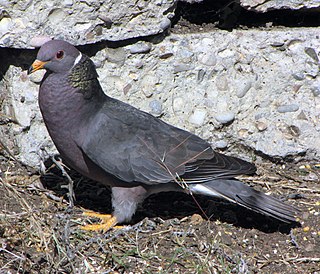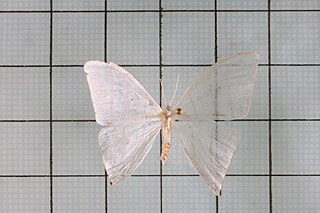
The band-tailed pigeon is a pigeon native to the Americas, being the largest pigeon native to North America. They are a native species throughout the Southwestern United States and Mexico, extending down to Peru.

The ribbon seal is a medium-sized pinniped from the true seal family (Phocidae). A seasonally ice-bound species, it is found in the Arctic and Subarctic regions of the North Pacific Ocean, notably in the Bering Sea and Sea of Okhotsk. It is distinguished by its striking coloration, with two wide white strips and two white circles against dark brown or black fur.

The melon barb is a common species of cyprinid fish that is endemic to rivers in Goa, Karnataka, Kerala and Tamil Nadu in the Western Ghats of South India. They live in a tropical climate in water that typically has a pH of 6.0—6.5, a water hardness of around 5 dGH, and a temperature range of 22–26 °C (72–79 °F). It grows to a length of 6 centimetres (2.4 in). This species can also be found in the aquarium trade.

The banded water snake or southern water snake is a species of mostly aquatic, nonvenomous, colubrid snakes most commonly found in the Midwest, Southeastern United States.

The broad-striped Malagasy mongoose or broad-striped vontsira is a species of Galidiinae, a subfamily of mongoose-like euplerids native to Madagascar. The species contains two known subspecies: Galidictis fasciata fasciata and Galidictis fasciata striata.

Digama is a genus of moths in the family Erebidae described by Frederic Moore in 1858. It is distributed in South Africa, China, throughout India, Sri Lanka, Myanmar and Australia.

Leeches are segmented parasitic or predatory worms that comprise the subclass Hirudinea within the phylum Annelida. They are closely related to the oligochaetes, which include the earthworm, and like them have soft, muscular segmented bodies that can lengthen and contract. Both groups are hermaphrodites and have a clitellum, but leeches typically differ from the oligochaetes in having suckers at both ends and in having ring markings that do not correspond with their internal segmentation. The body is muscular and relatively solid, and the coelom, the spacious body cavity found in other annelids, is reduced to small channels.

Miltochrista is a genus of moths of the family Erebidae, subfamily Arctiinae. The genus was erected by Jacob Hübner in 1819.

Udea is a genus of snout moths in the subfamily Spilomelinae of the family Crambidae. The genus was erected by Achille Guenée in 1845. The currently known 216 species are present on all continents except Antarctica. About 41 species are native to Hawaii.

Pyrausta is a speciose genus of moths of the family Crambidae. The genus was erected by Franz von Paula Schrank in 1802.

Ditrigona is a genus of moths belonging to the subfamily Drepaninae. The genus was erected by Frederic Moore in 1888.

Haementeria ghilianii, commonly known as the Amazon giant leech, is one of the world's largest species of leeches.
Striatochrista radians is a species in the moth family Erebidae.
Striatochrista zebrina is a species in the moth family Erebidae, found in southern Asia.
Striatochrista maculifasciata is a species in the moth family Erebidae, found in Southeast Asia.
Striatochrista multistriata is a species in the moth family Erebidae, found in Southeast Asia.
Striatochrista nigralba is a species in the moth family Erebidae, found in Southeast Asia.

Laubuka fasciata is a species of cyprinid fish endemic to river systems in Kerala, India. It is known as Malabar Hatchet Chela. The fish was first discovered in 1958 in the Anamalai streams by the Keralite fish scientist Eric Godwin Silas. The species was named Fasciata because of it shiny stripe on the body.
Smilia fasciata is a species of treehopper belonging to the family Membracidae. It was first described by Charles Jean-Baptiste Amyot and Jean Guillaume Audinet-Serville in 1843.

Striatochrista is a genus of erebid moth.













